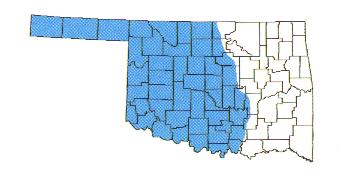Threadsnake
Rena dissectus
Rena dissectus
HARMLESS
Note: Oklahoma now has 1 species of threadsnake, the New Mexico threadsnake (Rena dissectus), and 1 subspecies, the Plains threadsnake (Rena dulcis dulcis). They are not commonly seen and they bear a strong resemblance to each other. It's for those reasons that they are included together on this ID page. These snakes were formerly listed in the genus Leptotyphlops.
Description:
A smooth, worm-like snake; reddish-brown or pink, with a blunt head and tail. The belly is either white or pink, and the eyes are small black spots on the side of the head.
Size:
Adults 5 - 10 inches (13 - 25 cm)
Prey:
Eggs, larvae, and pupae of termites and ants.
Reproduction:
A clutch of 2 - 7 eggs is laid late June to July. Females watch over incubating eggs and may share nesting sites with other females. Hatchlings are about 2 " (7 cm) long.
Habitat:
Stony hillsides, prairies, and in sandy or rocky desert areas.
Other Information:
Active in the evening and at night. This burrowing snake is usually only seen on the surface following a rain storm. It is most commonly found in loose, damp soil under logs and rocks.
The New Mexico threadsnake is found in the northern half of this range map.
The Plains threadsnake is found in the southern half of this range map.
Why doesn't the range map show this species in my county?
Note: Oklahoma now has 1 species of threadsnake, the New Mexico threadsnake (Rena dissectus), and 1 subspecies, the Plains threadsnake (Rena dulcis dulcis). They are not commonly seen and they bear a strong resemblance to each other. It's for those reasons that they are included together on this ID page. These snakes were formerly listed in the genus Leptotyphlops.
Description:
A smooth, worm-like snake; reddish-brown or pink, with a blunt head and tail. The belly is either white or pink, and the eyes are small black spots on the side of the head.
Size:
Adults 5 - 10 inches (13 - 25 cm)
Prey:
Eggs, larvae, and pupae of termites and ants.
Reproduction:
A clutch of 2 - 7 eggs is laid late June to July. Females watch over incubating eggs and may share nesting sites with other females. Hatchlings are about 2 " (7 cm) long.
Habitat:
Stony hillsides, prairies, and in sandy or rocky desert areas.
Other Information:
Active in the evening and at night. This burrowing snake is usually only seen on the surface following a rain storm. It is most commonly found in loose, damp soil under logs and rocks.
The New Mexico threadsnake is found in the northern half of this range map.
The Plains threadsnake is found in the southern half of this range map.
Why doesn't the range map show this species in my county?
